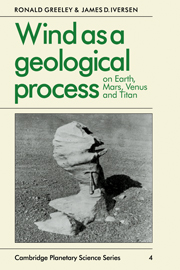Book contents
- Frontmatter
- Contents
- Preface
- 1 Wind as a geological process
- 2 The aeolian environment
- 3 Physics of particle motion
- 4 Aeolian abrasion and erosion
- 5 Aeolian sand deposits and bedforms
- 6 Interaction of wind and topography
- 7 Windblown dust
- Appendix A Nomenclature and symbols
- Appendix B Small-scale modeling of aeolian phenomena in the wind tunnel
- Glossary
- References
- Index
Preface
Published online by Cambridge University Press: 16 November 2009
- Frontmatter
- Contents
- Preface
- 1 Wind as a geological process
- 2 The aeolian environment
- 3 Physics of particle motion
- 4 Aeolian abrasion and erosion
- 5 Aeolian sand deposits and bedforms
- 6 Interaction of wind and topography
- 7 Windblown dust
- Appendix A Nomenclature and symbols
- Appendix B Small-scale modeling of aeolian phenomena in the wind tunnel
- Glossary
- References
- Index
Summary
Ralph Bagnold – an engineer by training, a military man by profession, and in many ways a geologist at heart – melded his interests into an elegant study of aeolian processes that has spanned many decades. In 1941 Bagnold published the first edition of his book, The Physics of Blown Sand and Desert Dunes. Often referred to simply as ‘Bagnold's classic book’, it is indeed a classic in every sense of the word. The fact that nearly every subsequent paper dealing with aeolian processes refers to the Bagnold book bears testimony that the basic principles described by him are essentially correct and have withstood the test of time.
Our book deals with aeolian processes in the planetary context. It is not our intent to ‘replace’ Bagnold's book or the research it represents. We learned that was neither required nor possible early in our own research program! Instead, we have built upon the solid foundation laid by Bagnold, testing the relationships defined by him through different approaches, and extrapolating the results to other planetary environments by attempting to predict how aeolian processes operate on Mars, Venus and, perhaps, Titan, the largest of the saturnian satellites.
We begin with an introduction to aeolian processes and a general overview of aeolian activity on the planets. We then discuss, in Chapter 2, the requirements for aeolian activity – a dynamic planetary atmosphere and a supply of particles capable of being moved by the wind – and describe in Chapter 3 the physical processes involved in particle movement by the wind. In Chapters 4 and 5 we describe wind-eroded and wind-deposited features and landforms.
- Type
- Chapter
- Information
- Wind as a Geological ProcessOn Earth, Mars, Venus and Titan, pp. xi - xiiPublisher: Cambridge University PressPrint publication year: 1985



